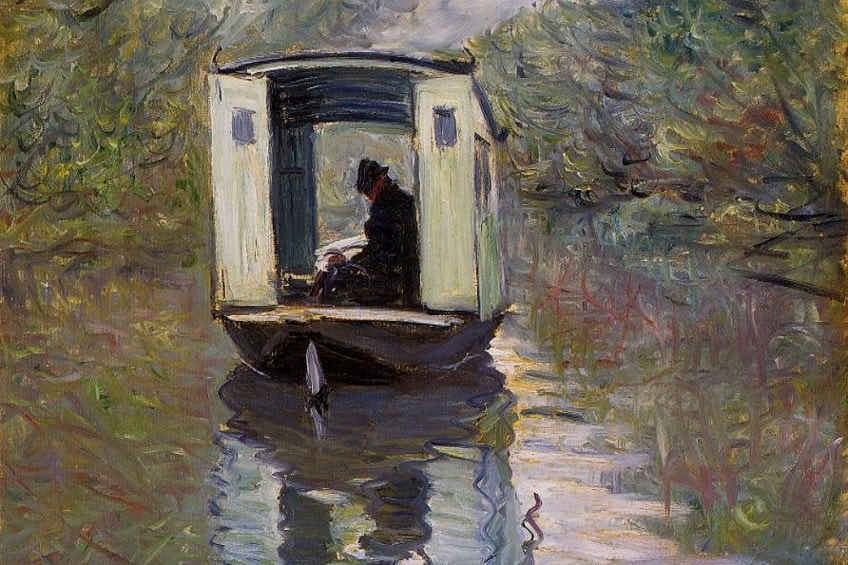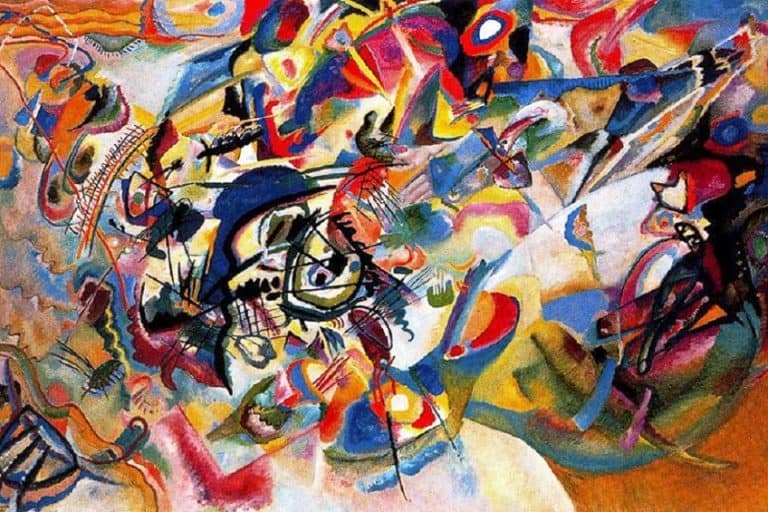Famous Monet Paintings – 15 Artworks That Shaped Impressionism
You may have come across a few iconic artworks from the famous French Impressionist painter Oscar-Claude Monet. Whether it is his elegant lily pond paintings or his natural atmospheric brushstrokes, there is much to admire in a Monet work of art. Monet was the founder of the major art movement Impressionism, who paved the path for the emergence of Modernism, alongside his fellow contemporaries Edgar Degas, Paul Cézanne, and Édouard Manet. In this article, we will explore some of Claude Monet’s most famous paintings, including the number one painting series that continues to inspire many. Keep reading to learn about these iconic Monet paintings!
Table of Contents
- 1 Claude Monet: The Founder of Impressionism
- 2 15 Famous Monet Paintings You Need to Know
- 2.1 Le Déjeuner Sur l’herbe (1865-1866)
- 2.2 Camille (1866)
- 2.3 Bain à la Grenouillère (1869)
- 2.4 Impression, Soleil Levant (1872)
- 2.5 Jean Monet on His Hobby Horse (1872)
- 2.6 Poppy Fields near Argenteuil (1875)
- 2.7 Woman with a Parasol – Madame Monet and Her Son (1875)
- 2.8 Le Bateau-Atelier (1876)
- 2.9 Haystacks, End of Summer (1891)
- 2.10 Rouen Cathedral: The Portal (Sunlight) (1891 – 1892)
- 2.11 Houses of Parliament (1899 – 1901)
- 2.12 Bridge Over a Pond of Water Lilies (1899)
- 2.13 Le Jardin de l’Artiste à Giverny (1900)
- 2.14 San Giorgio Maggiore at Dusk (1908 – 1912)
- 3 The Most Famous Monet Painting: Nymphéas (1897 – 1926)
- 4 Frequently Asked Questions
Claude Monet: The Founder of Impressionism
The era of Impressionism marked a new age of artists, who chose to steer away from the picture-perfect depiction of landscapes and other subjects. The original founder of the word “Impressionism” was Monet, which was realized through one of his paintings titled, Impression, Soleil Levant (1872), which translated to Impression, Sunrise. In an attempt to rebel against the Salon, Monet and a group fellow French Impressionists decided to host their own exhibition known as the exhibition of the “rejects”, which was held in 1874.
Since the first Impressionist exhibition, Monet gradually received more recognition for his unique painting style, as practiced in such an atmospheric and effortless way. His style of outdoor painting, which captured subjects in their natural environments at different times of the day was known as “en-plein air” and started to gain popularity among other global artists who sought to join the Impressionist movement in Paris.
Since his formative years, and like many of the greatest European masters, Monet had a keen interest in the arts, specifically in drawing and painting.

| Date of Birth | 14 November 1840 |
| Date of Death | 05 December 1926 |
| Place of Birth | Paris, France |
| Place of Death | Giverny, France |
| Associated Art Movements, Themes, and Styles | Impressionism, Modernism, Modern Abstraction, Modern art, landscapes, seascapes, portraiture, water, floral painting, outdoor light, nature, visibility, and abstraction |
| Mediums | Painting and drawing |
15 Famous Monet Paintings You Need to Know
Monet’s art not only provided us with some of the most iconic visual images that formed the basis of reference for Impressionism art but also left us with insight into his daily life and the aspects that were most important to him. Below, you will find our selection of the most famous Monet paintings to date, from the painterly brushstrokes in the Houses of Parliament to the sculptural textures of the Rouen Cathedral series.
Le Déjeuner Sur l’herbe (1865-1866)
| Date | 1865-1866 |
| Medium | Oil on canvas |
| Dimensions (cm) | 248.9 x 218 |
| Where It Is Housed | Musée d’Orsay, Paris, France |
Painted in response to a painting by Édouard Manet, Monet’s Luncheon on the Grass depicts Gustave Courbet, another prolific French artist, among a group of people enjoying a picnic. The painting is an unfinished piece composed of two panels and is currently housed at the Musée d’Orsay. The painting was abandoned by Monet due to his circumstances at the time.
According to Monet, he used the painting as security since he could not afford to pay his rent.
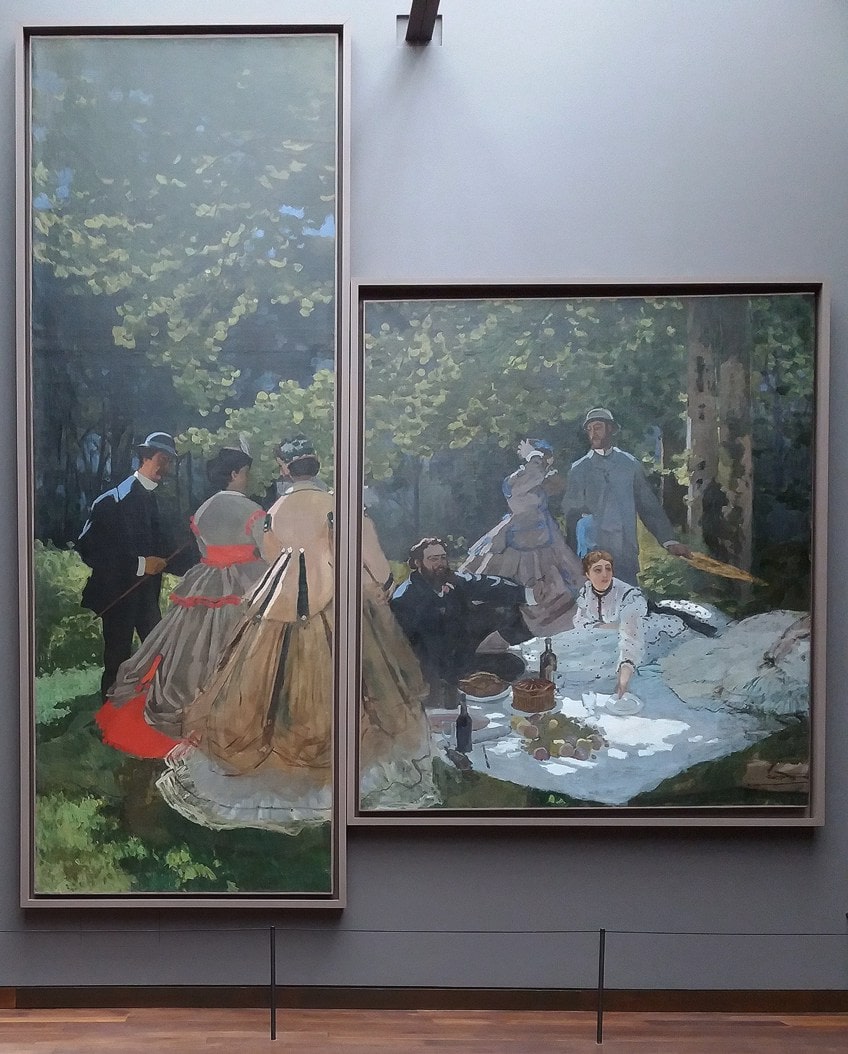
The unfinished artwork was unfortunately stored in a cellar, which caused it to collect mold. When Monet returned to collect his painting, he decided to cut the painting up into three segments. What we see today is what was salvaged at the time, but this did not stop Monet.
Shortly after, Monet created a new sketch of the scene, which can be viewed at the Pushkin Museum in Moscow.
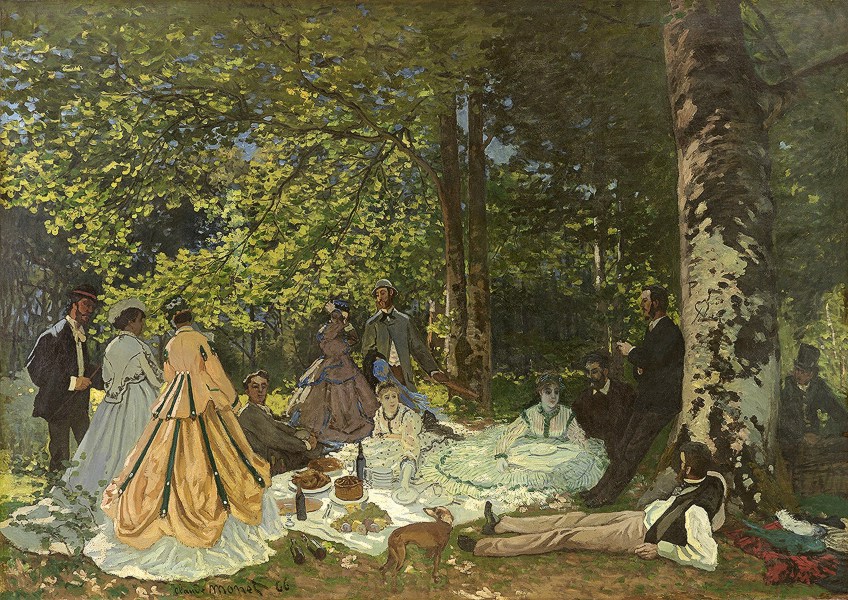
Camille (1866)
| Date | 1866 |
| Medium | Oil on canvas |
| Dimensions (cm) | 231 x 151 |
| Where It Is Housed | Kunsthalle Bremen, Bremen, Germany |
A known rule-breaker, Monet decided to paint his girlfriend Camille Doncieux in the same style as the portraits used for members of the aristocracy. In this painting, Camille is seen depicted as a full-length figure in a green dress, characteristic of the fashion of the time and representative of the contemporary, avant-garde femme beauty of 1866.
Monet painted her at an angle, with Camille glancing downward as her back faces Monet.
It has been said that this was also the last known painting by Monet that received praise from the Salon, which he had thereafter lost complete favor with. Camille was painted in an astonishing four-day span, just in time for critics to dish out their opinions.

Bain à la Grenouillère (1869)
| Date | 1869 |
| Medium | Oil on canvas |
| Dimensions (cm) | 74.6 x 99.7 |
| Where It Is Housed | The Metropolitan Museum of Art, New York City, United States |
Accompanied by fellow French artist Pierre-Auguste Renoir, Monet’s love for water scenes was evident in his 1869 painting Bain à la Grenouillère. During this time, Monet and Renoir found themselves in a tight financial situation, hence their attempt to produce a stunning painting paid off.
The idea behind the painting came to Monet in a dream and after a few ad hoc sketches, the artist and his friend took to the canvas.
As some may dream today, the La Grenouillère was an ideal spot for an artist since it was not only a resort, but also a spa with a floating cafe. The only difference is that it was not as glamorous as you might imagine. It was the hub and a true reflection of Parisian society, accompanied by “swindlers” and unsavory individuals alike.

Impression, Soleil Levant (1872)
| Date | 1872 |
| Medium | Oil on canvas |
| Dimensions (cm) | 48 x 63 |
| Where It Is Housed | Musée Marmottan Monet, Paris, France |
First exhibited in 1874, Impression, Soleil Levant received equal parts of harsh criticism and praise from critics across France. This famous Monet painting depicted a view of Le Havre in Normandy, which was also the artist’s hometown. Most critics on the conservative side seemed to agree with the notion that Monet’s painting was “unfinished” and a complete miss on the technique he preached.
On the other hand, critics who sided with Monet deemed his work a “revolutionary” move toward Modernism and a true depiction of the future.
This Monet art piece not only caught the attention of critics, but years later, also caught the attention of Youssef Khimoun and Philippe Jamin, who almost got away with stealing the painting from the Musée Marmottan Monet in 1985.
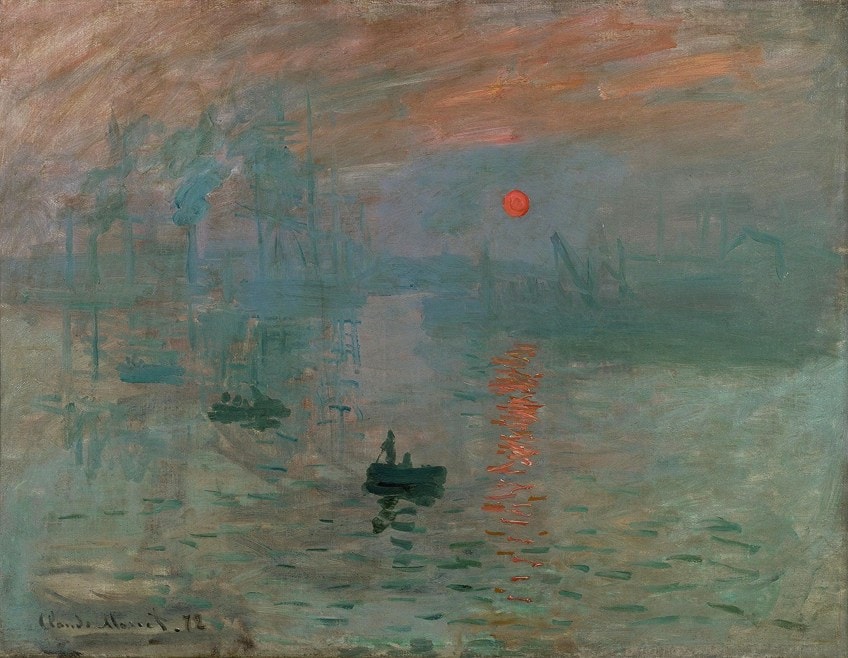
The making of the title of Impression, Soleil Levant was spoken about by Monet himself. In reference to his hazy style of painting, he simply stated “Put Impression” since the painting would not be perceived as what it was, as a view of the port, Le Havre. Although the term “Impressionism” was not solely used by Monet at the time, his hastened decision in titling the work is what informed the movement and the association between Impressionism as a style of painting.
Monet thus pioneered a new genre for 19th-century artists, who were soon greatly influenced by the rough and free-flowing brush work of Monet.
Jean Monet on His Hobby Horse (1872)
| Date | 1872 |
| Medium | Oil on canvas |
| Dimensions (cm) | 60.6 x 74.3 |
| Where It Is Housed | Metropolitan Museum of Art, New York City, New York |
One thing about Monet is that he always painted subjects that were close to his heart. Jean Monet on His Hobby Horse is a painting of the artist’s eldest son, which was never exhibited for the public but kept as part of the family archive by Monet. The painting shows Monet’s five-year-old son on his tricycle in their new backyard.
This painting has been compared to Titian’s equestrian paintings, as a form of celebration for the artist’s success at the time.
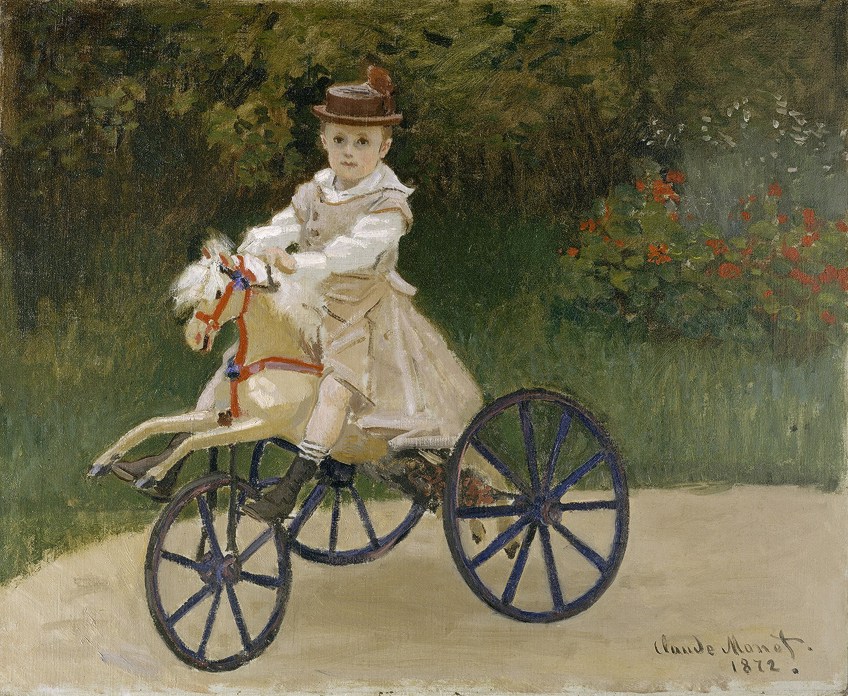
Poppy Fields near Argenteuil (1875)
| Date | 1875 |
| Medium | Oil on canvas |
| Dimensions (cm) | 54 x 73.7 |
| Where It Is Housed | Musée d’Orsay, Paris, France |
Monet met his soon-to-be wife, Camille, in 1865 when she modeled for a few of Monet’s art pieces. The two had a child together and after a period of tumultuous consequences due to their relationship, they married in 1870. Poppy fields near Argenteuilis one of Monet’s most famous works characterized by the beautifully stippled red poppies of Argenteuil in 1871, where the couple relocated. In the foreground of the painting, one can see the artist’s wife and child, Jean, enjoying a stroll in the poppy field. Unfortunately, his wife Camille was faced with a decline in health and the artist took to painting to help relieve the emotional turbulence.
This painting can be considered one of the first indications of Monet’s move towards abstraction, as seen through his hazy brush strokes and softly blended colors on the field.
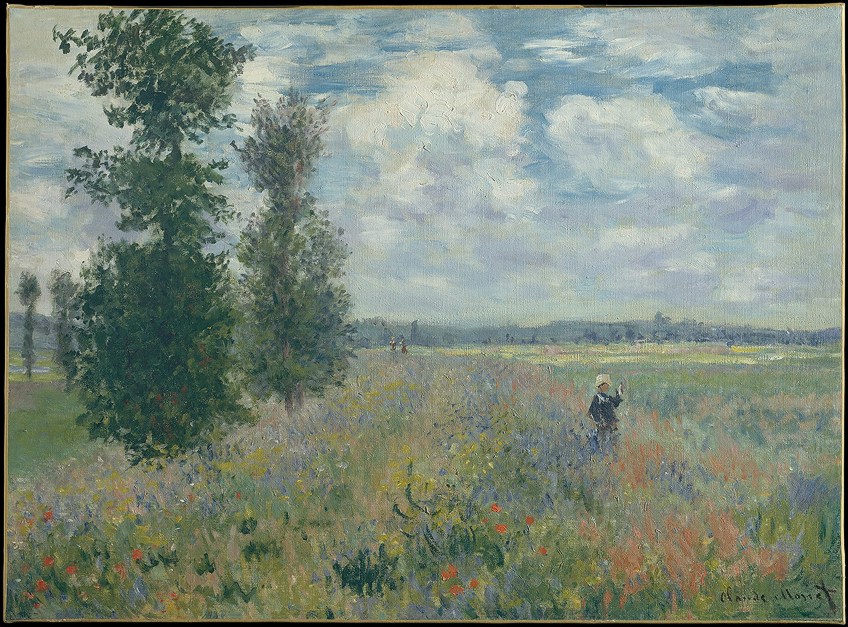
Woman with a Parasol – Madame Monet and Her Son (1875)
| Date | 1875 |
| Medium | Oil on canvas |
| Dimensions (cm) | 100 x 81 |
| Where It Is Housed | National Gallery of Art, Washington D.C., United States |
Making its debut in 1876 in the second saga of Impressionist exhibitions, Woman with a Parasol – Madame Monet and Her Son is a brilliant display of Monet’s ability to transfer his new style onto his subjects. It is reported that the painting was executed in one session for seven hours straight.
The casual atmosphere evoked by the painting is also special in that it shows us a glimpse into the artist’s personal life and time spent on a day out with his family, as it appeared to Monet in real time.

As if an angel, Monet painted Camille standing at the top of a hill with the rays of sunshine casting a spectacular white light behind her. Monet’s skill in experimenting with light and shadow can be seen from the light being blocked by Camille’s parasol to the shadowy field covered by her silhouette.
The direction of Monet’s short brush strokes also indicates a slight breeze and perhaps the way that the clouds moved in the background, as he witnessed this casual scene.
Le Bateau-Atelier (1876)
| Date | 1876 |
| Medium | Oil on canvas |
| Dimensions (cm) | 72.2 x 60 |
| Where It Is Housed | Barnes Foundation, Philadelphia, Pennsylvania |
Also known as The Studio Boat, Le Bateau-atelier was an outdoor painting by Monet executed in 1876 depicting Monet’s first “studio-boat”. Monet’s investment in a boat was crucial to his ability to paint water scenes of Argenteuil, particularly the River Seine.
Another painting by his close companion Édouard Manet in 1874 shows Monet painting on his treasured studio boat with his wife Camille.
The water, as an escape, was an important experience for the artist as it allowed him an artistic and emotional release from the pressure of modernity. Another famous painting showing Monet enjoying his new lifestyle on a boat is Boating (1874).

Haystacks, End of Summer (1891)
| Date | 1891 |
| Medium | Oil on canvas |
| Dimensions (cm) | 60 x 1000 |
| Where It Is Housed | Musée d’Orsay, Paris, France |
Also titled as Grainstacks at the End of Summer, Morning Effect, this famous Monet painting was created in 1891 and formed part of the artist’s Haystacks series. Monet’s many studies of the same scene and subject reflected his interest in atmospheric changes in color and light on the field and the shadows cast by the haystacks. He painted a total of around 30 haystack paintings between 1890 and 1891.
The main subject in the series revolves around the piles of harvested wheat from the fields in Giverny.
Rouen Cathedral: The Portal (Sunlight) (1891 – 1892)
| Date | 1891 – 1892 |
| Medium | Oil on canvas |
| Dimensions (cm) | 99.7 x 65.7 |
| Where It Is Housed | The Metropolitan Museum of Art, New York City, United States |
Rouen Cathedral was among Monet’s most recognizable painting series inspired by the architecture of the cathedral as it stood in the changing light conditions of the day. The series was executed between 1891 and 1892, and was created using textured brushwork to reflect the sculptured facade of the building. Monet would prepare rough paintings at the site and later move to his studio to work independently as he refined the structures.
Houses of Parliament (1899 – 1901)
| Date | 1899 – 1901 |
| Medium | Oil on canvas |
| Series Size | 100 |
| Dimensions (cm) | 81 x 92 |
| Where It Is Housed | The Art Institute of Chicago, Illinois, United States and other collections |
Apart from Monet’s many sources of inspiration spanning architecture, gardens, and bodies of water, he was also drawn to the silhouette of the houses of parliament and the different effects of light on the Thames River. Between 1899 and 1901, Monet embarked on many trips to London to capture multiple views of the British Parliament and the Palace of Westminster.
During this time, he also left behind his previous process of painting in one spot for long periods and used to travel back to Giverny to complete his works.
Bridge Over a Pond of Water Lilies (1899)
| Date | 1899 |
| Medium | Oil on canvas |
| Dimensions (cm) | 92.7 x 73.7 |
| Where It Is Housed | The Metropolitan Museum of Art, New York City, United States |
Monet was also known to venture into horticulture and his passion eventually grew to the point where he purchased property near Giverny for the purpose of pleasure and for “motifs to paint”. Depicted in Bridge over a Pond of Water Lilies is Monet’s own water lily garden, which was the pinnacle of his style and is now a recognizable feature in a “Monet painting”. His water lily series began in 1899 and progressed to a series of 12 paintings, each created with as much passion and skill as Bridge over a Pond of Water Lilies.
In Monet’s discovery of his new muse, he stated “I saw, all of a sudden, that my pond had become enchanted… since then, I have had no other model”.
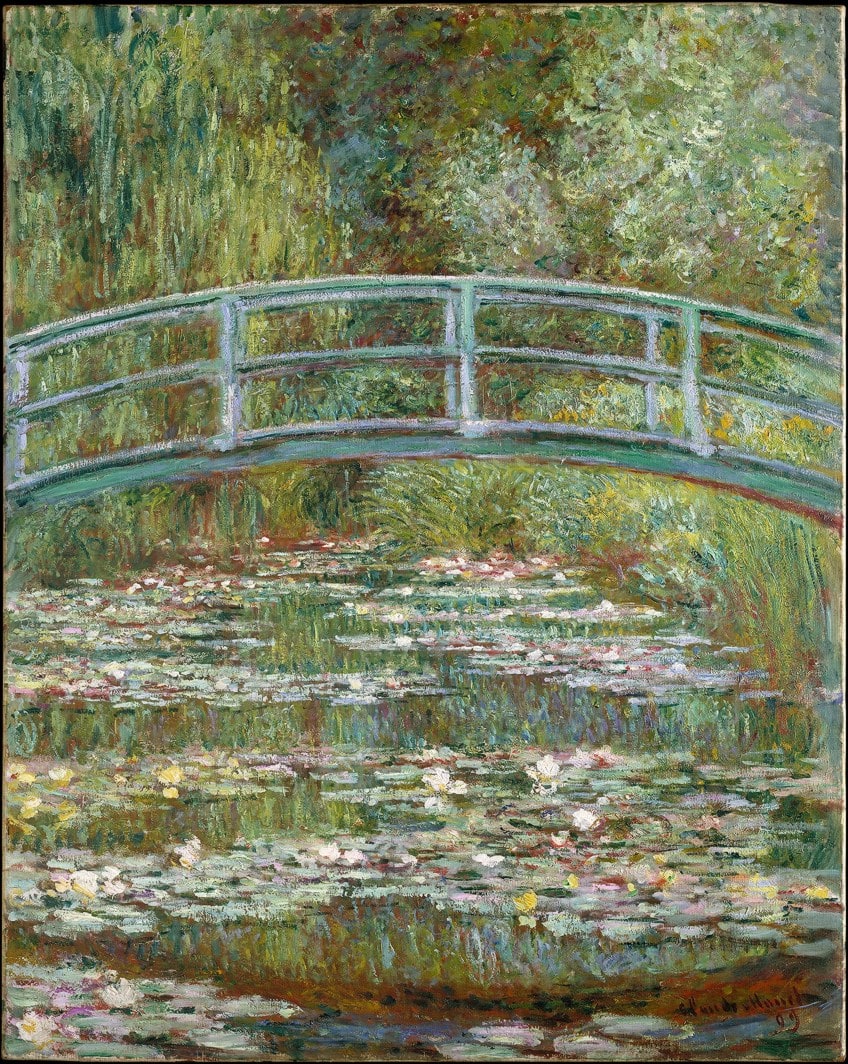
Le Jardin de l’Artiste à Giverny (1900)
| Date | 1900 |
| Medium | Oil on canvas |
| Dimensions (cm) | 81.6 x 92.6 |
| Where It Is Housed | Musée d’Orsay, Paris, France |
Depicting a stunning array of irises in lilacs, violets, and pinks, Monet painted The Artist’s Garden at Giverny at the age of 60 in 1900. During this time, the artist was engaged in two major series; one of the gardens in Giverny and the other of London’s River Thames. While the imagery may appear confusing to those unfamiliar with Impressionism, Monet skillfully portrays the irises at an angle, planted directly under trees. In the distance, between the trees, is the water where you can catch a glimpse of the artist’s home in the water’s reflection.
Upon first glance, the subjects seem to blend together but as you take a closer look, you can see Monet’s careful play with light to highlight the painting’s focal point and help guide the viewer into the scene.
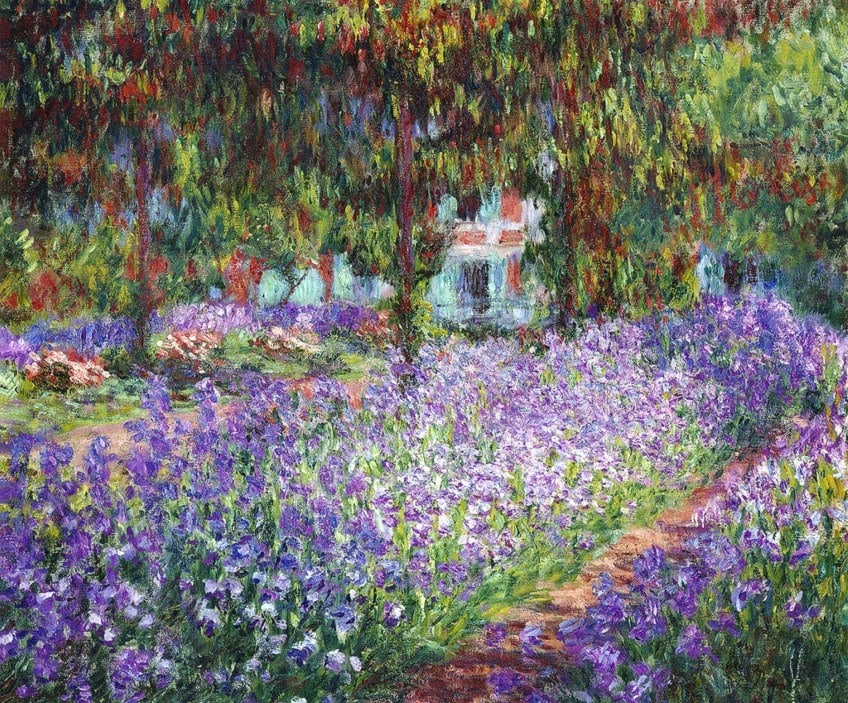
San Giorgio Maggiore at Dusk (1908 – 1912)
| Date | 1908-1912 |
| Medium | Oil on canvas |
| Dimensions (cm) | 65.2 x 92.4 |
| Where It Is Housed | National Museum Cardiff, Wales, United Kingdom |
Translated in English as Sunset in Venice or San Giorgio Maggiore by Twilight, this is just one famous Monet painting out of the series on Venice, which commenced in 1908. Monet envisioned this scene from his hotel window at the Britannia. Now owned by the National Museum Cardiff in Wales, the painting was also made during a period when Monet began to lose his sense of sight due to cataracts.
As an artist, he leveraged his experience to provide his own impression of the sunset, which was illustrated with much vibrancy.

The Most Famous Monet Painting: Nymphéas (1897 – 1926)
| Date | 1897 – 1926 |
| Medium | Oil on canvas |
| Series Size | 250 |
| Where It Is Housed | Multiple museums and Private collections |
Among these famous Monet artworks, which is the most famous? Simple! It is none other than his 250-painting series, Nymphéas, which he worked on between 1897 and 1926. Also known as the Water Lilies, the French Impressionist’s passion for his water lily garden, as mentioned in our overview of Bridge over a Pond of Water Lilies, is the highlight of the artist’s career. Some might argue that Impression, Soleil Levant was perhaps the most famous; however, we would say that it was instead the most significant painting.
The lily garden in Giverny was the primary source of Monet’s last 30 years in painting, a period that gave birth to many of his famous works.
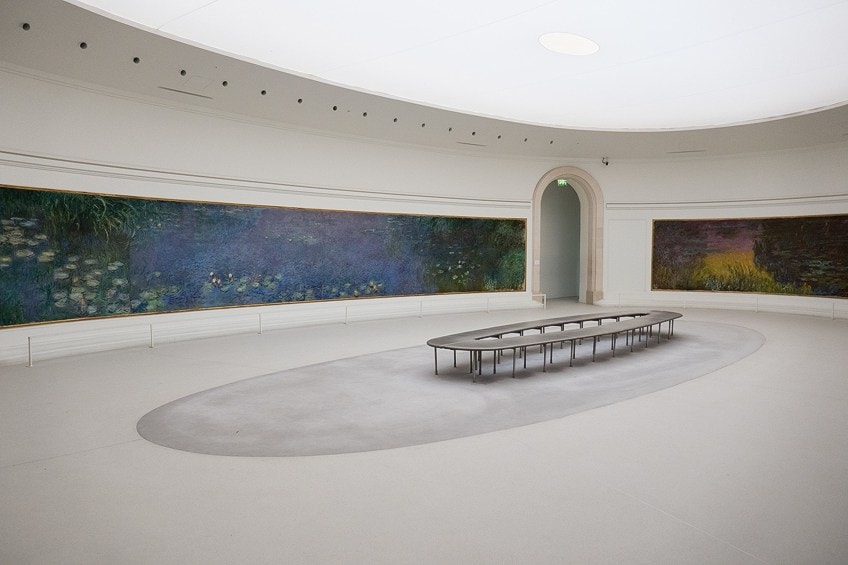
The largest work from the Nymphéas series is housed at the Musée de l’Orangerie in Paris, which is also home to many other paintings of the Impressionist era. In this series, Monet also played with orientation and included vertical, horizontal, and even circular orientations for the series. The Nymphéas series is spread across multiple institutions worldwide, including the New York Metropolitan Museum of Art, the Museum of Grenoble, the San Antonio Museum of Art, the Municipal Museum of Art in Japan, the Beyeler Foundation in Basel, and the National Gallery of Australia, among many others.
We hope this article helped you in narrowing down the search for some of Monet’s most famous paintings. Monet’s art continues to uphold his legacy in many locations, in addition to preserving his title as “the father of Impressionism”. Staying true to his view and avoiding the trap of either Realism or Romanticism, Monet produced a total of around 2000 paintings in his lifetime.
Take a look at our Monet paintings webstory here!
Frequently Asked Questions
What Are the Major Themes in Monet’s Paintings?
In the numerous Monet paintings, one can narrow down the major themes in terms of color, light, and an experimental approach to the combination of the two. Monet also engaged in portraiture and casual scenes of his everyday life. His water lily scenes can also be considered a major theme since they took up to 30 years to complete. Other themes include sunlight, contrast, time, and the elements of the weather.
What Was Claude Monet Inspired By?
Monet was inspired by many things such as his water lily garden in Giverny, Japanese art and culture, natural forms, light, and experiences such as his military service spent in Algeria.
How Did Monet’s Cataract Condition Affect His Painting?
By the time the artist turned 72, he had developed cataracts in both eyes and only sought out surgery years later. This caused him to see the world differently since cataracts affect vision and color. Monet saw the world through reds and yellows, apparent in his paintings depicting prominent red and yellow hues from 1912 onwards. After Monet received surgery, it has been speculated that he could see colors found on the ultraviolet spectrum.
How Many Claude Monet Paintings Depict Camille Doncieux?
Camille Doncieux featured in just over 30 Monet paintings, as well as artworks painted by Monet’s contemporaries, Manet and Renoir. Before Camille married Monet, she was an art model.
Who Is Alice Hoschedé?
Alice Hoschedé was Monet’s second wife. Camille passed away in 1879 and soon thereafter, Monet married Alice Hoschedé, who married Monet in 1892. Alice was previously married to a man named Ernest Hoschedé, who died just before Monet married Alice.
Isabella studied at the University of Cape Town in South Africa and graduated with a Bachelor of Arts majoring in English Literature & Language and Psychology. Throughout her undergraduate years, she took Art History as an additional subject and absolutely loved it. Building on from her art history knowledge that began in high school, art has always been a particular area of fascination for her. From learning about artworks previously unknown to her, or sharpening her existing understanding of specific works, the ability to continue learning within this interesting sphere excites her greatly.
Her focal points of interest in art history encompass profiling specific artists and art movements, as it is these areas where she is able to really dig deep into the rich narrative of the art world. Additionally, she particularly enjoys exploring the different artistic styles of the 20th century, as well as the important impact that female artists have had on the development of art history.
Learn more about Isabella Meyer and the Art in Context Team.
Cite this Article
Isabella, Meyer, “Famous Monet Paintings – 15 Artworks That Shaped Impressionism.” Art in Context. July 26, 2022. URL: https://artincontext.org/famous-monet-paintings/
Meyer, I. (2022, 26 July). Famous Monet Paintings – 15 Artworks That Shaped Impressionism. Art in Context. https://artincontext.org/famous-monet-paintings/
Meyer, Isabella. “Famous Monet Paintings – 15 Artworks That Shaped Impressionism.” Art in Context, July 26, 2022. https://artincontext.org/famous-monet-paintings/.


